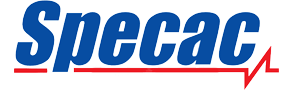For collecting Infra Red spectral data of liquid or solid samples it is desirable to gain a spectral range from 4000cm-1 to 400cm-1. Conventionally liquid transmission cells with KBr windows were used but this has its disadvantages.
An alternate method for spectral collection is to use the Attenuated Total Reflectance (ATR) technique, whereby any liquid sample type is bought into direct contact with an ATR crystal material and internally reflected and measurable light from the sample crystal interface results in a spectrum being collected for the sample from a specific penetration depth into the sample material itself.
In order to achieve a similar spectral range of collection for the range 4000cm-1 to 400cm-1 from the ATR technique a monocrystalline type Ilia diamond ATR crystal element can be used.
The Specac Quest ATR accessory offers the choice of a diamond, ZnSe or germanium ATR crystal puck to be used on a dedicated optical unit with mirrored reflectance optical components only. This optical combination enables the full transmission spectral range capability of the ATR crystal chosen to be achieved.
Equipment and Method
The spectra were collected on a Thermo Nicolet iS5 instrument using the standard room temperature detector system set at a resolution of 4cm-1 for 16 scans with a gain setting of 1.
Three different volatile solvents were used for the study.
- Methanol.
- Acetone.
- Cuvertin X8536 (from LORD) - (This is a proprietary solvent mixture of Xylene (60-100%) and Ethylbenzene (< 25%) in content, used for polymer surface stripping and preparation).
The Quest ATR Accessory P/N GS10801-B was used with the single reflection diamond extended range ATR crystal puck option on the black surface coloured optical unit for the ATR measurement of a volatile liquid sample,.
A volatiles cover P/N GS10825 was used to cover over the volatile solvent or solution when this had been spotted into position over the diamond ATR crystal. In order to obtain a good sealing from the O-ring at the base of the volatiles cover and to enable long term containment and contact of the volatile liquid sample over the ATR crystal, the flat anvil P/N GS10820 was fitted to the anvil arm assembly of the Quest ATR accessory and this was employed to force down onto the top of the volatiles cover.
When the volatile liquid sample had been prepared in this way it was then ready for spectral data collection. Each sample was repeated twice for consistency of measurement.
Spectral Data
Figures 1, 2 and 3 show the infrared spectra collected for these volatile liquid samples.
Discussion
The time that the sample will cover the crystal to a sufficient depth of penetration for collecting a representative IR spectrum before losing the sample contact is based on the actual mobility and volatility of a liquid sample type.
For the three volatile liquid sample types chosen for this study, from prior testing there was just enough time within a 60 second period to acquire a consistent representative ATR spectrum for each sample before sufficient contact was lost, after spotting the sample into position over the diamond crystal and leaving exposed to the atmosphere.
.jpg)
Figure 1. Methanol solvent with volatiles cover on diamond crystal puck of Quest ATR Accessory
.jpg)
Figure 2. Acetone solvent with volatiles cover on diamond crystal puck of Quest ATR Accessory
By arranging the volatiles cover into position over the spotted sample to cover the diamond and then by clamping the volatiles cover down into position to seal the liquid sample into place, each solvent sample was measured for a minimum of 10 minutes hold time with no loss of signal absorbance intensity in the spectrum obtained from the start of the hold time and after a 10 minute hold period.
The spectra shown as Figures 1, 2 and 3 signify the volatile liquid sample type taken after a 10 minute hold time against the diamond crystal puck with the volatiles cover clamped into place.
The resulting spectrum for the residue left is seen as Figure 4. and although relatively weak in spectroscopic band intensity, is a good match for syndiotactic polypropylene material. This indicates that this polymeric type material has been deposited as a thin film from the evaporation of the volatile solvent components of the solution.
.jpg)
Figure 3. Cuvertin X8536 solvent/solution with volatiles cover on diamond crystal puck of Quest ATR Accessory
.jpg)
Figure 4. Cuvertin X8536 solvent/solution residue after evaporation from the diamond crystal puck of Quest ATR Accessory
Conclusion
Even though volatile liquid samples (solutions or solvents) can be studied by IR liquid transmission cells, the study of liquid samples by ATR can be an inherently easier way of handling the sample than using a traditional liquid transmission cell assembly. However, as ATR is a reflection technique, sample measurement takes place at the surface only to a depth of a few microns rather than as a “bulk” measurement through 10’s to 100’s microns of path length in a transmission cell. Also, the choice of ATR crystal is determined by the same consideration of an ATR crystal being chemically compatible with the sample that can be used to obtain the optimum infrared spectral data needed.

This information has been sourced, reviewed and adapted from materials provided by Specac.
For more information on this source, please visit Specac.